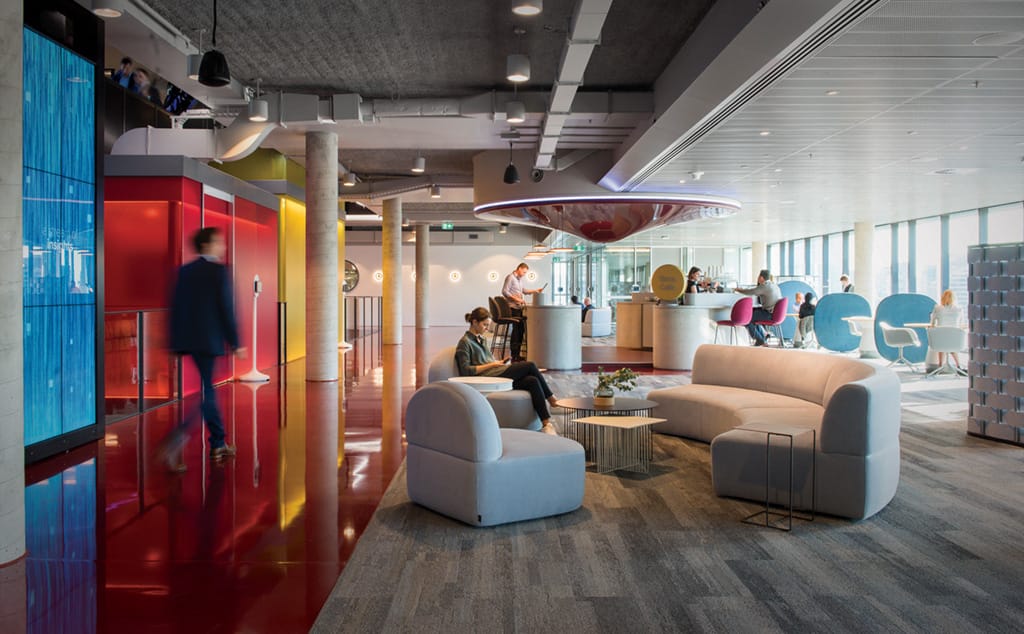
Business as Unusual
PwC pushes the design and technology boats out to meet clients in a whole new way.
Text:/ Christopher Holder
Images:/ Nicole England
‘Business as usual’ simply wasn’t an option. PwC could see its work was changing. It could also see that expectations from clients were changing. Perhaps only 10 years ago, as a provider of financial and consulting services, PwC might pride itself in its solid advice, dependability and its global reach. These attributes, although still prized, were now not sufficient. Clients were looking for a fresh perspective, and being able to solve problems collegiately rather than simply outsourcing it to PwC.
Things were changing rapidly, such that when it came time to refit and/or move its east coast city offices, the PwC partners and executive were looking for radical transformation…
CLIENTS’ RIGHT
This issue we take a walk through the client collaboration floors of PwC’s new Barangaroo and Riverside Quay offices.
Both these fitouts had ASL onboard as the AV consultant. The AV integration was handled by Fredon Technology.
Both sites have four levels of client collaboration floors. They comprise an amalgam of meeting spaces of different shapes and sizes, flexible lounge areas (where AV can be rolled in and out to accommodate meetings), and hospitality areas.
As a PwC client you’re greeted by the welcome crew, assisted in connecting with your PwC Host, offered barista-made coffee and shown to the preferred meeting space.
It’s a different experience. Not just here in Australia but potentially anywhere in the world. It’s saying: “We do things differently”. PwC CIO, Hilda Clune puts it this way: “PwC’s purpose is to solve important problems and build trust in society. There is an emerging need for spaces that are flexible and can be used for sessions with clients, where we co-create a solution to a business problem. This scenario needs richness and choice of high-tech, low-tech and tactile tools to support design thinking and accelerated solution design.”
TECH SAVVY ARCHITECT
The interior architect for PwC’s Melbourne and Sydney offices was FutureSpace. AV Asia Pacific spoke with FutureSpace Managing Director, Angela Ferguson. It’s not every issue we chat with the architect but this is no ordinary fitout. Read on:
AV Asia Pacific: Just how much of a radical departure is the design?
Angela Ferguson: PwC’s brief was to create an exceptional end-to-end client experience — triggering different expectations and changing perceptions. It was all about options and their clients choice in the way they want to work with PwC. PwC were really open to new ideas — they actively asked for this. We had a huge amount of scope and they were willing to take a big leap of faith. In other words, it’s a seriously radical departure.
AV Asia Pacific: What are some of the key design decisions you made to shake things up?
Angela Ferguson: First of all, it doesn’t look like an office. It’s more like a blend of a hotel, hospitality, retail, and even the airline industry. Secondly, it’s more open than any workspace you’ve ever seen before. There’s a whole range of different settings across the client collaboration floors that offer different degrees of privacy and different types of technology. So whatever manner of meeting you could possibly think of, there’s a space that will support you to do that.
AV Asia Pacific: Technology is an intrinsic feature of the interior design, which is rare.
Angela Ferguson: AV is too often left to the very end and rarely properly integrated into the interior architecture, which is always a big problem. Especially as technology changes so quickly, I think clients leave that decision to the last minute and the AV becomes a bit of a bolt-on as a result; not something that’s a holistic part of the process.
We like to get technology involved early. If you’re having conversations about AV early it means that you get a better result in the end.
AV Asia Pacific: In your experience, why is AV often an afterthought?
Angela Ferguson: Sometimes clients don’t appreciate how important it is. I also think it’s the rate at which technology changes. If you’re doing a project that’s 18 months or two years from being completed, often they want to leave that decision until much later, because they want the latest technology.
WHO’S WHO
Interior Architect: FutureSpace
Builder (Sydney): Lend Lease
Fitout (Sydney): Build Corp
Build & Fitout (Melbourne): Mirvac
AV Consultants: Audio Systems Logic (ASL)
AV Integration: Fredon Technology
Digital Content & UX: Downstream
Web-based Building Control: ACA
AV AsiaPacific: What were the initial discussions you had with ASL regarding the AV?
Angela Ferguson: We had ASL onboard as AV consultant early. They were fantastic. There were two types of technology to consider: There was the day-to-day technology which was around AV and connecting staff and clients. But there was also the signature technology; the technology that enhances the client experience.
We also had Downstream onboard for that and the whole process started with PwC, because they wanted to do something that was very different from a technology point of view. They wanted something that was of the future, in terms of technology, not gimmicky and offered a real value add to the client experience. From there, between FutureSpace, Downstream and ASL, it was a really collaborative process the whole way through.
AV Asia Pacific: Can you give us an insight into some of the thought processes behind the feature tech?
Angela Ferguson: As an example, PwC wanted to ensure insights could be easily shared with clients. So we’ve got the digital waterfalls that run throughout the four levels of the client collaboration floors in Sydney and Melbourne. These digital waterfalls are touchscreens: you can interact with them and input your preferences and it will ‘rain’ a constant stream of relevant information, tailored to your needs.
That’s an example of designing the infrastructure around the technology; Downstream not only helped deliver the technology part of that piece, but also the content with PwC.
AV Asia Pacific: How have the client floors been received in the hustle and bustle of daily commerce?
Angela Ferguson: The uptake from PwC’s clients and people has been just fantastic. Both have embraced the spaces and they’re using them in exactly the way that they were intended.
There’s always that nagging tinge of ‘oh I hope this works’, because it was a risk for PwC to do something so bold compared to what the market stereotypically knows professional services to be. They’re doing something different. But people have really embraced this new way of working, this new level of openness, and it’s been amazing. And just the vibrancy and energy and buzz whenever you go there is just fantastic.
AV’S NEW MASTER
It’s hard not to feel change in the air: change in the way big business wants to leverage technology to nail its innovation credentials to the mast; change in the way architects will need to be more collaborative to ensure the proper integration of tech into contemporary design; changes in what’s expected of A-List integrators faced with sky-high client expectations in terms of how quickly projects are turned around (okay, that’s always been an issue) and how to problem solve on the hoof, even as systems are commissioned. AV may have been a technology layer that needed to be managed by the facilities team, now it’s technology that’s another citizen of the network. PwC with its Extron XTP matrix switching isn’t entirely on the network but with the CIO as the ultimate authority, AV has a new master.
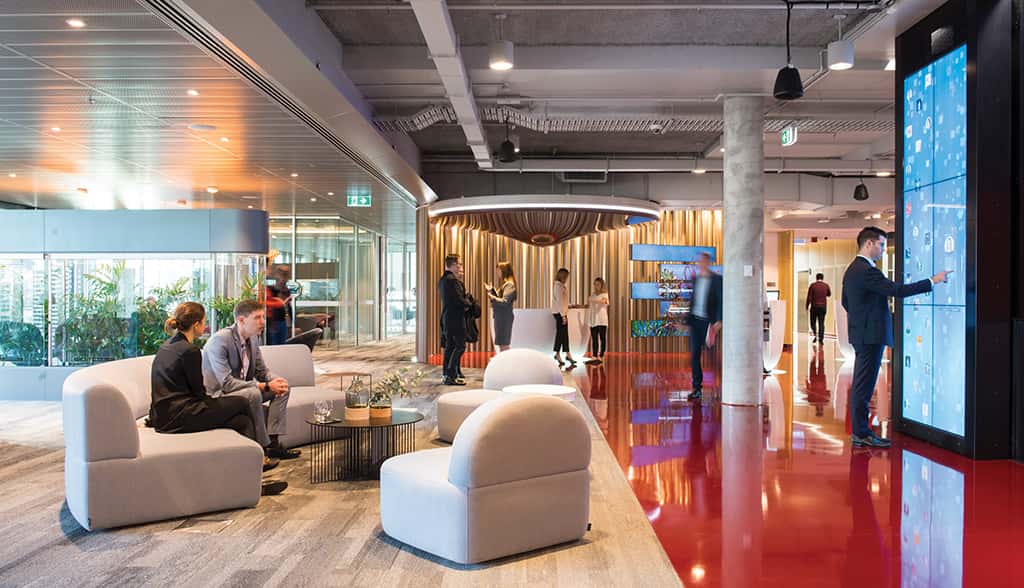
OPEN PLAN: SVSI ON A TROLLEY
Wide open airport lounge-style meeting spaces certainly appeals to many. But if a meeting requires VC, collaboration or presentation technology you have a choice: decamp to a closed meeting space or bring the tech to the meeting.
ASL and Fredon have worked on a supercharged AV trolley to take care of just about any meeting requirement. The Gilkon trolley packs a Samsung display with a multi-touch overlay, Mersive Solstice collaboration and a wireless presentation system and plugs into a floorbox with only power and a category cable. ASL’s Alex Burns, and Fredon Technology’s GM Nick Orsatti and Project Manager Justin Anders explain the setup:
Alex Burns, ASL: You can plug a trolley into any floor box. There’s no further configuration required other than the basic plugging into the right data socket, from there you’re able to broadcast to any and every single trolley directly over the wired network as well as doing it wirelessly. We used SVSI’s 1080p video-over-IP system to achieve this.
PwC was willing to try new things and try new product, which is how we were able to take the leap of faith with the SVSI system.
How it works: you can nominate one of the trolleys as a main presenter. You can choose any of the four inputs — HDMI, USB3, WePresent wireless presenter and the Mersive Solstice wireless collaboration system. From there you can work directly on that station and broadcast that out to other trolleys. You can take in other video conferencing feeds directly from the likes of a Cisco SX80 codec. The output of that is available on the SVSI network and can be sent to any trolley.
Flexibility is the main drawcard. You can place a trolley wherever you like inside that network and not have to go through expensive patching or having to deal with HDBaseT matrixing, which is typically fixed to that socket.
So it’s a big benefit and that’s why we were quite happy to put SVSI to the test, and the SVSI guys’ assistance was invaluable in getting both the 4K [for the 10×2 video wall pictured later] and the traditional 1080p going.
Why Solstice? We’ve been using Mersive Solstice in a number of commercial projects now, and clients like its usability. It’s very friendly from that perspective; being able to get a whole group of people onto the platform, being able to collaborate with documents, pushing that backwards and forwards and having the 4K outputs. It’s one of the first collaboration systems to go 4K, so you get the most out of an 85-inch screen.
Justin Anders, Fredon: The SVSI solution interacts with mobile trolleys, and heavily relied on the infrastructure of the cabling that we put in for floor boxes of the open spaces.
The AV had to be dynamic as the thoughts that come in — grab your trolley, move to a floor box and without any active equipment being moved around the place the SVSI system is there to support them for any needs they brainstorm, come up with solutions, whether it be whiteboard, 85-inch trolleys on it, 55-inch trolleys as well.
That was the mandate from PwC, that it needed to have that robustness and flexibility. That was a key part and that came quite late in the project — it wasn’t on the Day 1 build of materials. It was definitely an integration challenge, to ensure it was supremely flexible and for it to be addressable under the ACA room booking system as well.
Nick Orsatti, Fredon: Credit needs to go to Extron for going on a journey with PwC, which is is why they have so much more HDBaseT product installed and a relatively small deployment of SVSI — it’s all about being fit for purpose to meet functional outcomes
And from a cost perspective a video-and-IP solution, whether that’s SVSI or something else that’s emerging, still has a significant cost element. That’s not always a hard cost — as in how much the endpoints cost; the encoders and decoders etc — but a lot of it is around the switching fabric.
Take SVSI as an example. You could set up a SVSI network on a commodity-grade switch. But in many corporate environments they’re underpinned by using an enterprise-grade switching fabric. So you didn’t really get the cost-benefit there. In other words, there are other considerations and constraints at play.
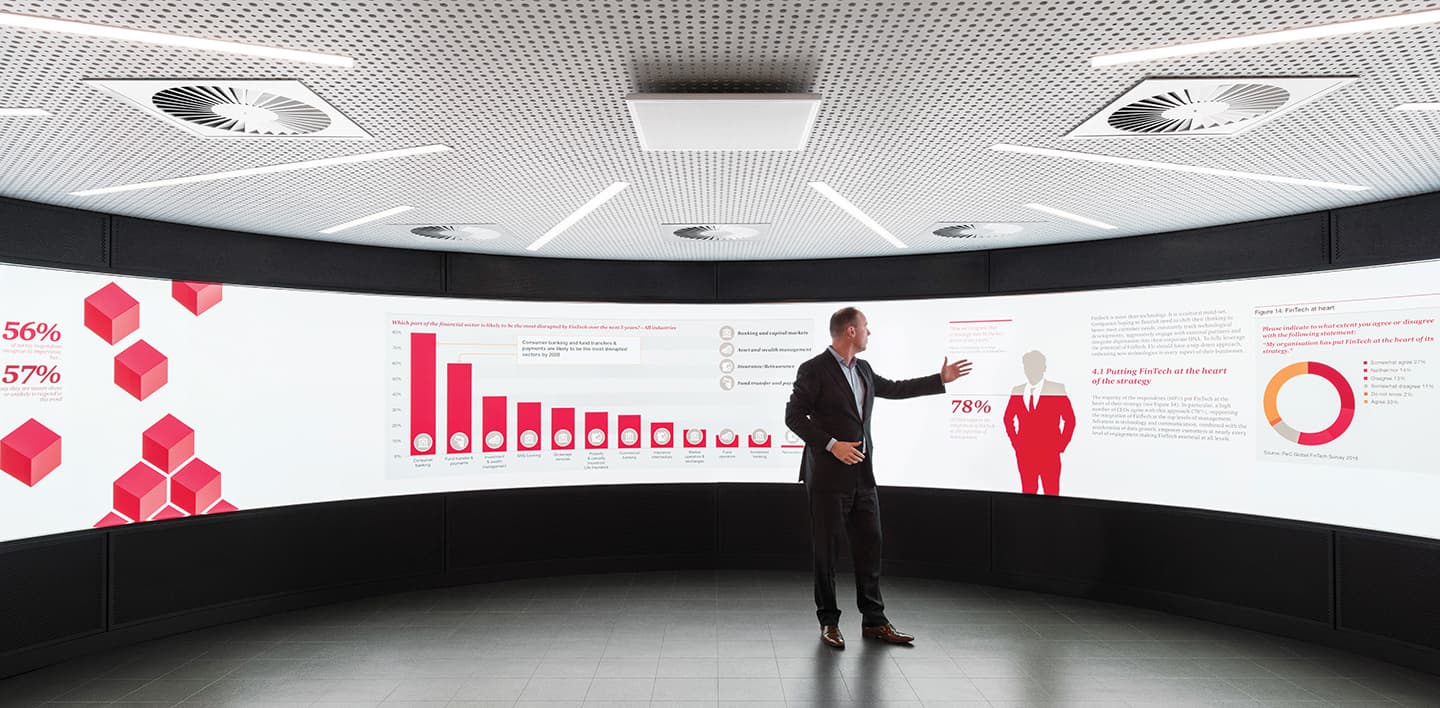
SHURE MXA CEILING
Nick Orsatti, Fredon: Shure’s MXA Dante-based ceiling array (pictured above) addresses the challenge of making technology fit into a space that has a lot of physical constraints. In spaces where you can’t have mics hanging from the ceiling, where they get in the way of projection sightlines or LCD sightlines.
When we first saw the ceiling arrays become available we were instantly attracted to the fact you could adapt the array to the size, shape and acoustic of the room in a granular fashion. Plus it obviously gets gear off the tables, which is especially useful when the tables need to move around. (The cost of moving components around and ensuring it all still works is a big one.)
So originally we planned to use a hybrid solution of different microphone types and we thought: ‘how about we take a more uniform approach, and make it easy to commission’. So we’ve used Shure MXA ceiling arrays and also Shure MicroFlex wireless as roving mics in events and town hall spaces.
The Shure MXA ceiling arrays plug straight into the Q-Sys Core. They’re very tightly integrated as platforms. You can control all of the Shure nodes and presets from within the Q-Sys environment. From an integrator’s perspective, that’s gold because you’re not trying to log into different devices that are on different subnets. When you’ve got no time to commission, the simpler you can make that process, the better.
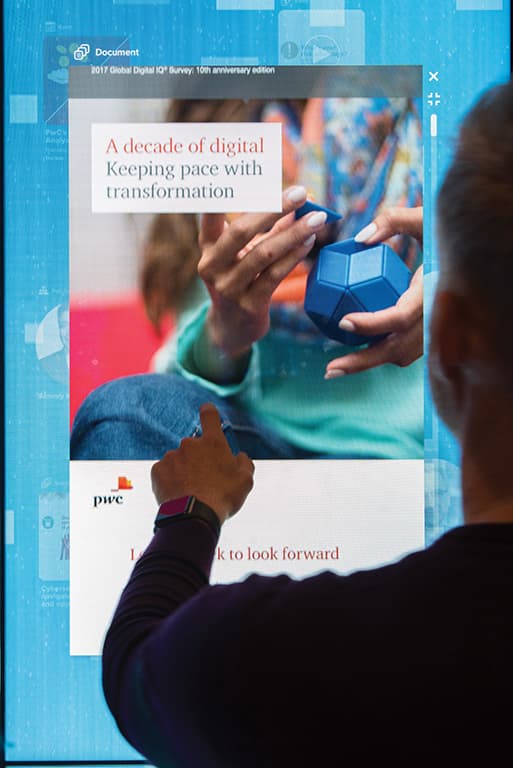
THE POWER OF TOUCH
Just about every display you see pictured is touch enabled. All the working screens are from Samsung with special purpose screens coming from Planar, Multitaction and LG. The level of interactivity, you’d have to say, is unprecedented. PwC CIO, Hilda Clune, elaborates:
Hilda Clune, PwC: Touch is an important element in engaging our audience and in the adoption of technology. As technology more frequently becomes the tool of choice for innovative and collaborative sessions, increasing the opportunity for touch technology naturally lifts the degree of interaction. In the more sophisticated experiences through the journey, the technology is designed to entice the person to engage in an intuitive way.
Justin Anders, Fredon: The idea is that touching and interaction is invited, in fact, it’s expected. Even in the smaller Google Hangout/Chrome box huddle spaces.
PwC’s welcome wall uses Planar displays with a PQ Labs touch overlay. We’ve used Multitaction displays for the 180° curved innovation hub space in Sydney. Conventional IR touch isn’t so suited to curved spaces like that.
Nick Orsatti, Fredon: The equivalent space in Melbourne is a little larger and we’ve used SiliconCore 1.5mm pixel pitch LED, which represents five contiguous HD images. There’s no touch on those screens; presentation only. That setup and the Multitaction version has tvONE CORIOmaster video wall processing behind it, to allow for the various use cases.
The team at Corsair Solutions support tvONE well and applied their talents to working on that video wall application. CORIOmaster looks to be well designed for presentation areas like this.
Alex Burns, ASL: I’ll say one thing about the guys at Corsair Solutions, they’re up for a challenge! They were active in the prototyping because we had some interesting scenarios. We were using the LG 58:9 Stretch display in Melbourne and some of the timing and the resolutions we presented to the CORIOmaster were a challenge. The guys from Corsair were there to assist with some of that and helped with some modifications, which is definitely to their credit.
SYDNEY HUB TECH
10× Multitaction MT555UTB 55-Inch Ultra Narrow Bezel Display
1× tvONE C3-540 Video Wall Processor
5× Meyer MM-4XP Loudspeakers + MM-10 sub
10× tvONE 1T-CT-654A HDBaseT Receivers
ESI Gigaport HD+ Audio Card
Listen Tech IR Hearing Augmentation
1× Ultralift J7095 10-Screen Video Wall Mount
5× Icron USB 3.0 Spectra 3022 USB Extenders
3× Nvidia M4000 Video Card for Display Computert
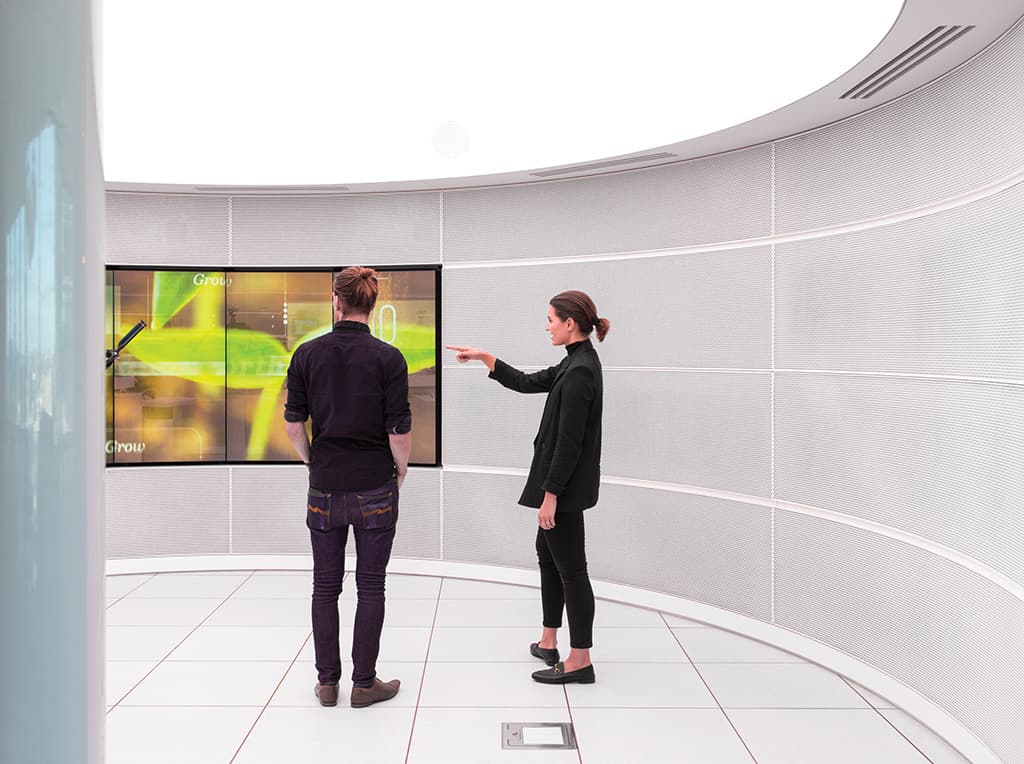
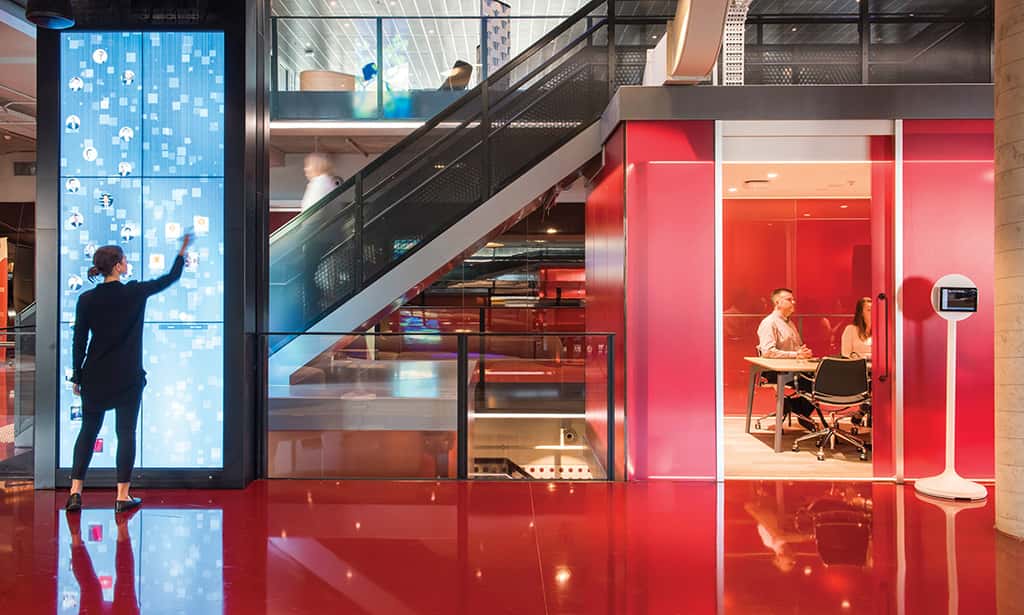
WELCOME WALL TECH
Extron USB Extender/Transmitter
10× Planar MX55HDU-V-ERO-100 55-inch LED-LCD Display
5× PQ Labs Multitouch Overlay (32 Point)
5× Radius Networks PiBeacon Bluetooth Beacon/Scanner
5× SoundTube CM62-EZs-II Ceiling Loudspeakers
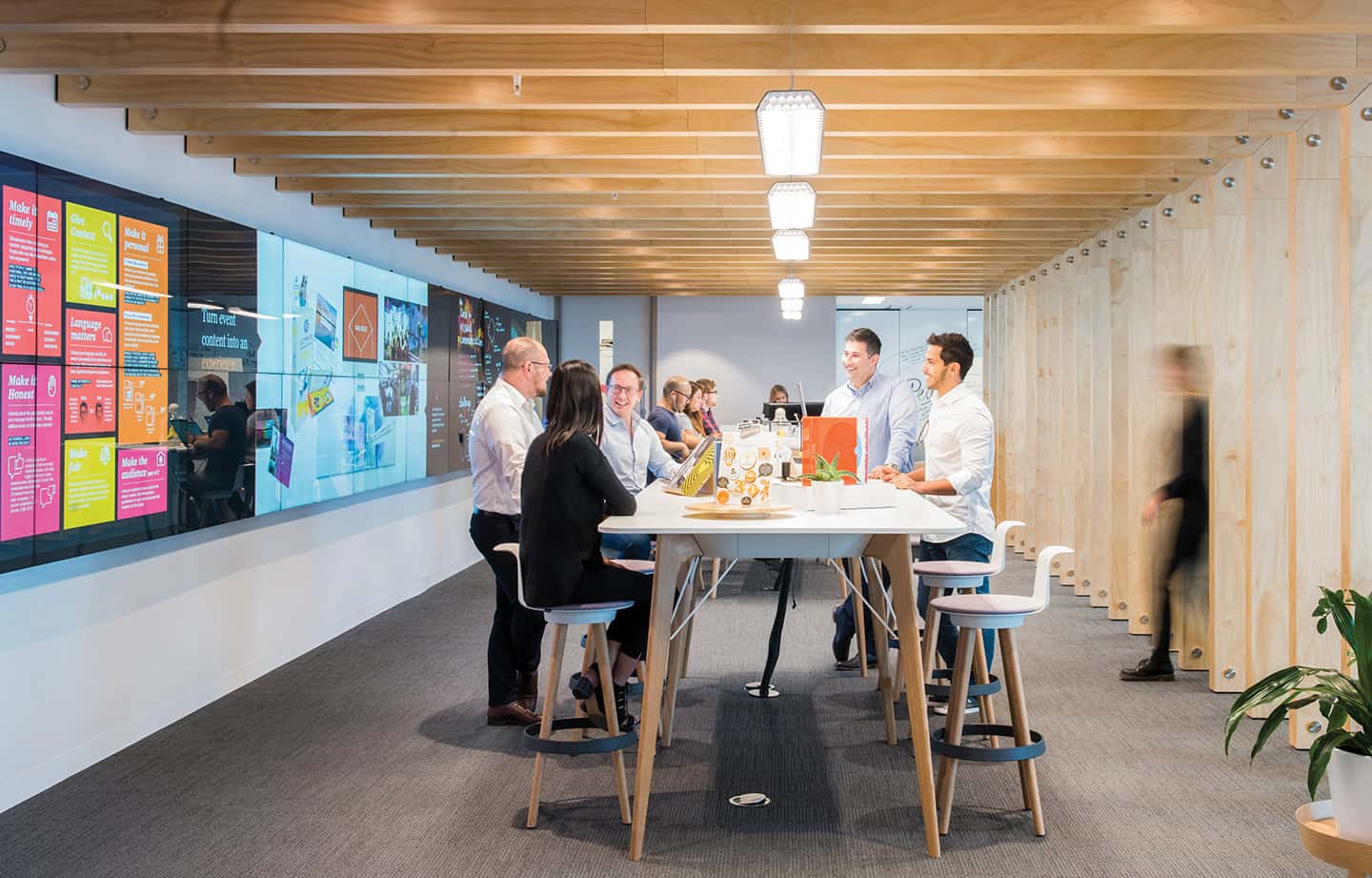
GET A ROOM: ACA DISRUPTION
The brains of the control aspects of the operation is the ACAEngine, a web-standard control platform that you can read all about elsewhere this issue. Any room (regardless of size/importance) or device connected to the corporate network has access to the control solution.
In small spaces such as huddle booths, the control interface might run on the staff member’s own phone, tablet or laptop. In larger meeting rooms, a mounted HP tablet is used to present the user interface. This is simply a webpage in locked-down kiosk mode.
“One of the biggest advantages of using a Windows tablet,” ACA’s Jonathan MacFarlane has noted, “is that it can be managed by the corporate IT team on a standard operating environment (SOE) image. What’s more, it can be purchased through existing IT suppliers such as Dell and fall under existing support and maintenance contracts.”
On the outside of certain meeting rooms is a Windows tablet running ACA’s web-based room booking interface. Essentially, this is a custom ACAEngine interface but instead of providing the standard room controls, it allows users to make room bookings. Staff can search for rooms by AV and capacity requirements using the ACA room finding app. This is a quick and easy way to find an available room that meets your specific needs and runs on mobile or desktop through any browser.
ACA integrates with PwC’s room booking system (CABS) to determine availability.
SECURITY ON THE NETWORK: NEEDING ANSWERS
Fredon Technology GM, Nick Orsatti reflects on the challenges of meeting IT’s stringent security standards:
“The security of the information in these spaces is of paramount importance. And it’s a real conundrum, maintaining security while meeting the the demands of a client’s functional outcomes.
“For example, on the PwC client collaboration floors, as a client I can reasonably expect wi-fi. We can provide guest wi-fi, but how do we enable that and allow internal people to use their wi-fi as well as guests and present on a collaboration system like Solstice? Or how do I ensure the Dante-enabled microphones aren’t picked up and recorded by someone with a virtual soundcard?
The stakes are definitely higher now, and IT teams are paying more attention to AV.
“I think one of the biggest announcements that came out of InfoComm17 was Audinate’s Dante Domain Manager. With more clients seeing the benefits of AoIP, Domain Manager is a hugely significant enabler for converged networks.
“Increasingly we’re working on projects where there are so many devices that we have split them up into different IP subnets. Domain Manager promises to assist greatly in managing the large scale deployment of real-time audio on converged networks with simplicity and control. Anything with an Audinate chip will automatically subscribe to Domain Manager and then you can effectively put some access control rules to lock it down.
“IT managers hate it when you can’t tell them what your device is: it’s not a PC, it’s not a printer, it’s not a server, it’s not a phone… What is this device? To them, it’s rogue. Then you ask him to break all the rules they’ve set up for uniformity to keep security in place.
“Spare a thought for the IT managers for a minute; it’s a challenge for them to stay across the ever-widening scope of everything that can and does reside on their integrated network.
“Equally, the IT skill set we need as integrators is now quite considerable — you can’t just sit there thinking, ‘Oh that’s a network issue, leave it to the IT guys.’”
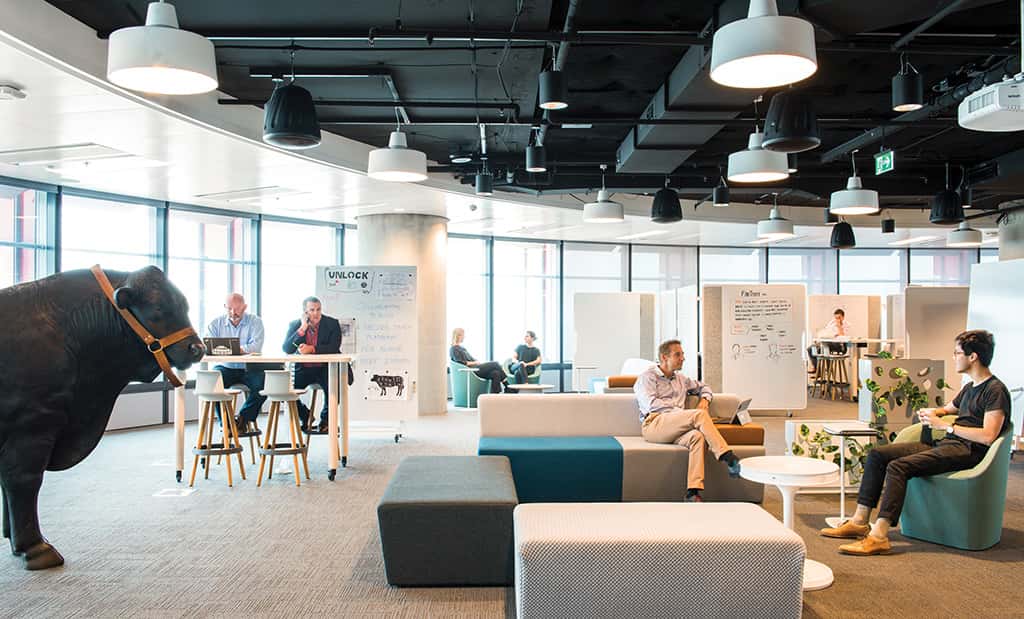
FROM THE CIO
Hilda Clune, PwC: A large portion of the investment in our new way of working is the significant uplift in the presence of technology, both AV and collaborative, in all styles of spaces. It forms a part of the fabric of the space, underpinning the meeting or session being held and is considered a part of the basic design of any meeting space. To further embed the capabilities, we have ensured consistency in both the technology and control set across both our people and client collaboration floors to further endorse the need for all to be able to use the technology, regardless of whether it is an internal or client meeting. Our client experience, and ease of access to technology has also been considered in meeting the emerging need for our clients to connect as we collaborate and co-create.
FLAME TREE
The LED Flame Tree in the Melbourne office is the creation of lighting designer to the stars, Bruce Ramus. The artwork extends through the four floors of the atrium then branches out below like the roots of a tree. Various, largely indigenously-styled, content changes with the Melbourne weather which famously can swing about from hour to hour.
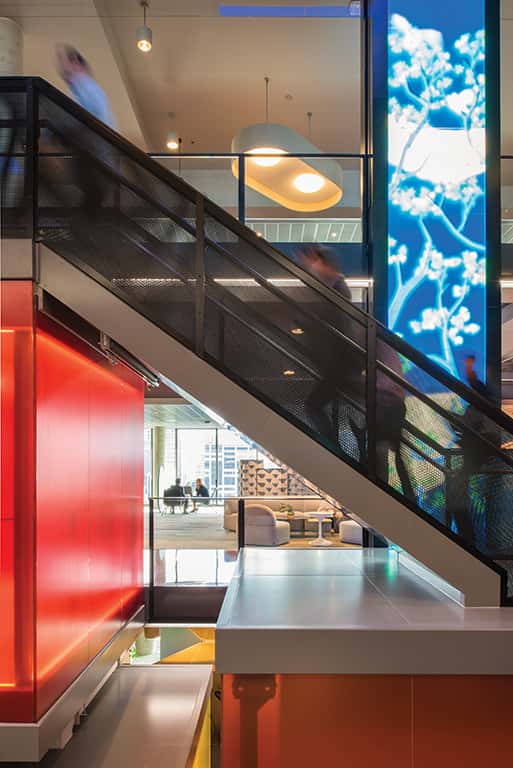
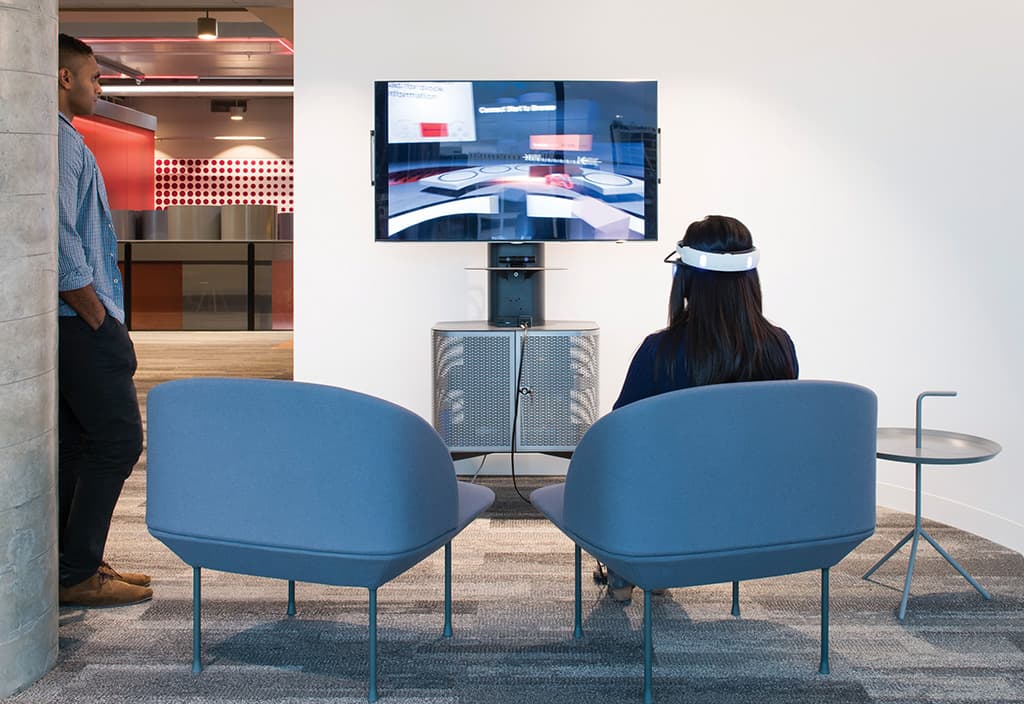
EXTRON: CONTROLLING TOUCH
Alex Burns: We used Extron’s new USB network-enabled transport for all the touchscreens. And that’s definitely a game-changer. Instead of a traditional one-cable transmitter connected to a receiver, it runs through an active network switch and a managed switch — it creates touch overlay matrixes. So if you’ve got two screens in a room and a single source, you can go to both screens and control those or switch between two different sources or more — we had multiple screens being able to have, say, four different floor boxes and doing network switching reliably.
WHAT’S ON THE TROLLEY
Gilkon FP8 Tilt & Mobile Screen Stands (pictured above)
Extron SW4 HDMI Auto-Switcher
Samsung DM55E Display with touch overlay
Lenovo USB3.0 Ultra Dock Docking Station
Radius Networks Rad Beacon USB Bluetooth Beacon
WePresent WiPG-1600 Wireless Presenter

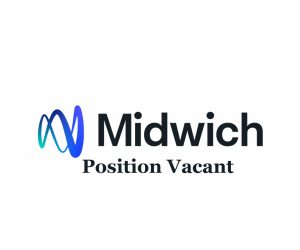
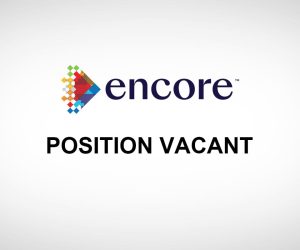


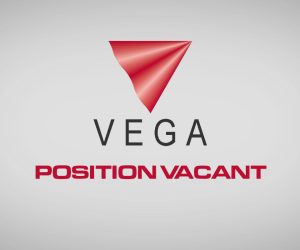
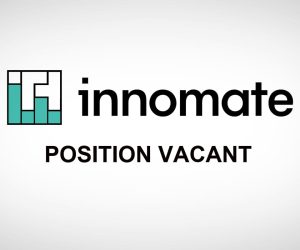
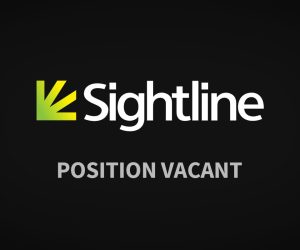
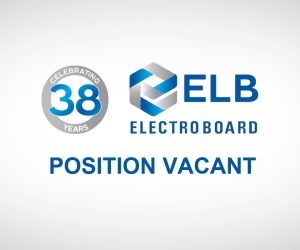
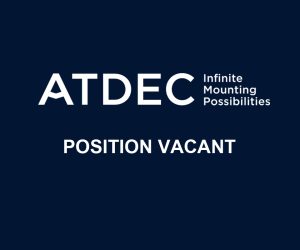
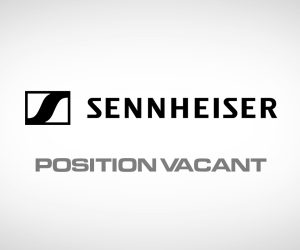
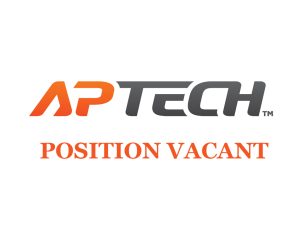


RESPONSES